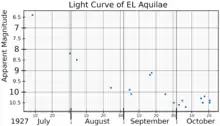EL Aquilae
EL Aquilae, also known as Nova Aquilae 1927 was a nova that appeared in 1927. It was discovered by Max Wolf on photographic plates taken at Heidelberg Observatory on 30 and 31 July 1927 when it had a photographic magnitude of 9. Subsequent searches of plates taken at the Harvard College Observatory showed the nova was fainter than magnitude 11.1 on 8 June 1927 and had flared to magnitude 6.4 on 15 June 1927.[5][7] It declined from peak brightness at an average rate of 0.105 magnitudes per day, making it a fast nova, and ultimately dimmed to about magnitude 21.[2] The 14.5 magnitude change from peak brightness to quiescence was unusually large for a nova.[3]
 | |
| Observation data Epoch J2000 Equinox J2000 | |
|---|---|
| Constellation | Aquila |
| Right ascension | 18h 56m 02.030s[1][lower-alpha 1] |
| Declination | −03° 19′ 20.43″[1] |
| Apparent magnitude (V) | 6.4[2] Max. 20.9[3] Min. |
| Characteristics | |
| Variable type | Classical Nova |
| Astrometry | |
| Proper motion (μ) | RA: −2.236[1] mas/yr Dec.: −6.157[1] mas/yr |
| Parallax (π) | 0.1601 ± 0.0779 mas[1] |
| Distance | approx. 20,000 ly (approx. 6,000 pc) |
| Other designations | |
Nova Aql 1927, AAVSO 1850-03, Gaia DR2 4255780873390406528[4] | |
| Database references | |
| SIMBAD | data |

All novae are binary stars, with a "donor" star orbiting a white dwarf so closely that matter is transferred from the donor to the white dwarf. Pagnotta & Schaefer argued that the donor star for the EL Aquilae system is a red giant, based on its position in an infrared color–color diagram.[8] Tappert et al. suggest that Pagnotta & Schaefer misidentified EL Aquilae, and claim that EL Aquilae is probably an intermediate polar, a nova with a main sequence donor star, based on its eruption amplitude and color.[3]
Notes
- The identification of the nova with this object is disputed, and it may actually be a fainter star several arc-seconds away
References
- Vallenari, A.; et al. (Gaia collaboration) (2023). "Gaia Data Release 3. Summary of the content and survey properties". Astronomy and Astrophysics. 674: A1. arXiv:2208.00211. Bibcode:2023A&A...674A...1G. doi:10.1051/0004-6361/202243940. S2CID 244398875. Gaia DR3 record for this source at VizieR.
- Payne-Gaposchkin, Cecilia (January 1958). "The Novae". Astrophysics II: Stellar Structure / Astrophysik II: Sternaufbau. p. 752. doi:10.1007/978-3-642-45908-5_10. ISBN 978-3-642-45910-8.
{{cite book}}:|journal=ignored (help) - Tappert, C.; Barria, D.; Fuentes-Morales, I.; Vogt, N.; Ederoclite, A.; Schmidtobreick, L. (October 2016). "Life after eruption - VI. Recovery of the old novae EL Aql, V606 Aql, V908 Oph, V1149 Sgr, V1583 Sgr and V3964 Sgr". Monthly Notices of the Royal Astronomical Society. 462 (2): 1371–1381. arXiv:1608.00527. Bibcode:2016MNRAS.462.1371T. doi:10.1093/mnras/stw1748. S2CID 119269130.
- "EL Aquilae". SIMBAD. Centre de données astronomiques de Strasbourg. Retrieved 2020-12-13.
- Duerbeck, Hilmar W. (March 1987). "A Reference Catalogue and Atlas of Galactic Novae". Space Science Reviews. 45 (1–2): 1–14. Bibcode:1987SSRv...45....1D. doi:10.1007/BF00187826. S2CID 115854775.
- Cannon, Annie J. (October 1927). "Photographic Observations of Wolf's Nova". Harvard College Observatory Bulletin. 851: 10–11. Bibcode:1927BHarO.851...10W.
- "Our Astronomical Column". Nature. 120 (3020): 419. 17 September 1927. Bibcode:1927Natur.120..419.. doi:10.1038/120419a0. S2CID 4104684.
- Pagnotta, Ashley; Schaefer, Bradley E. (June 2014). "Identifying and Quantifying Recurrent Novae Masquerading as Classical Novae". The Astrophysical Journal. 788 (2): 164. arXiv:1405.0246. Bibcode:2014ApJ...788..164P. doi:10.1088/0004-637X/788/2/164. S2CID 118448146.